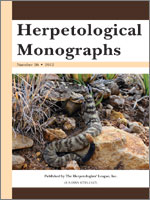We studied growth in snout–vent length (SVL) and body mass of Dusky Pygmy Rattlesnakes (Sistrurus miliarius barbouri) in Volusia County, Florida, with the use of mark–recapture techniques. Between February 1992 and December 2000, we PIT-tagged (Passive Integrated Transponder) 665 individuals of approximately 1 yr of age or greater that were subsequently recaptured at least once. Because snakes can be definitively aged at 1 yr, this resulted in a large sample of snakes of known age that were followed for up to 7 yr. Seventy-five of these individuals PIT tagged at 1 yr were identified from photographs of neonates born in captivity, allowing us to relate adult growth to neonate traits. Our data suggest that Pygmy Rattlesnakes in central Florida exhibit highly variable patterns of growth that are related to a mild climate that allows feeding and growth throughout the year, and to a fluctuating prey base that results in irregular growth patterns often unlike those predicted by typical growth equations such as the von Bertalanffy model. Snakes in our populations were surface-active throughout the year, and snakes with detectable prey in the gut were found in all months. Growth is most rapid in the first year, but growth rates did not differ markedly from other viperids occurring in more temperate areas. In their first year, Pygmy Rattlesnakes in Florida increased their mass over birth on average more than fourfold, and increased SVL 1.8-fold. Growth in both mass and SVL continued throughout life, with no clear indication of an asymptote in size. Multiple regressions of SVL and body mass against age showed a slight but significant effect of sex on both SVL and mass, though these differences were not apparent until snakes were approximately 4 yr. Males and females showed no difference in SVL growth rates or patterns of change in growth rate with age, but females grew faster in body mass than males. Body-mass growth rates did not decline with age in either sex. Rates of increase in SVL in the first year of life differed significantly among years, though these differences were not correlated with estimates of prey (frog) abundance. However, neither body size at birth or first-year growth rates was significantly related to size at 1 yr of age or with growth rates later in life. Inspection of individual growth records and characterization of records into categories defined here showed great variability in patterns of growth, with episodic growth occurring in most individuals, including larger adults. A year-round activity season may decouple feeding and growth in these snakes from the temporal constraints imposed on more northern snakes, resulting in greater variability in individual growth trajectories. Prolonged feeding opportunities may allow snakes with below-average feeding conditions in their first year to compensate for slower initial growth by opportunistic feeding and rapid bouts of growth at any time later in life.
How to translate text using browser tools
1 December 2012
Growth Patterns of Dusky Pygmy Rattlesnakes (Sistrurus miliarius barbouri) from Central Florida
Peter G. May,
Terence M. Farrell
ACCESS THE FULL ARTICLE

Herpetological Monographs
Vol. 26 • No. 1
December 2012
Vol. 26 • No. 1
December 2012
age
growth
mark–recapture
Pygmy Rattlesnake
Reptilia
Sistrurus miliarius
Viperidae




